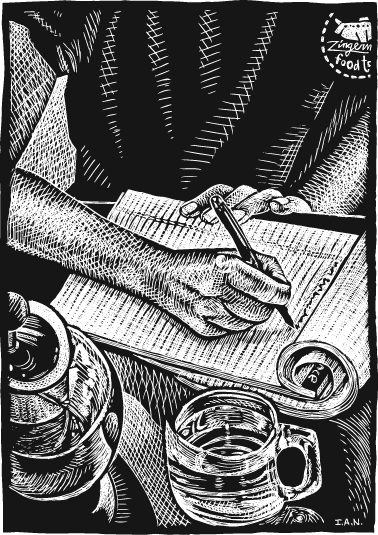Creating Creativity pt. 2
This is an excerpt from Zingerman’s Guide to Good Leading, Part 3: A Lapsed Anarchist’s Approach to Managing Ourselves. Available now at Zingerman’s businesses or through the Zingerman’s Press website!
Why Good Work Creates a Creative Culture
In truth, I couldn’t understand how it could be otherwise. How could you have an even kind of successful company, or employees who you thought were doing a good job, if creativity weren’t involved? The question caused me consternation, but it also made realize that we must have a different definition of what it means to do a “good job” than most mainstream organizations. The difference I realized was partly in the wording. When you hear about someone who does a “good job,” more often than not they’re being praised for follow- ing orders, completing tasks they’ve been assigned by their “superiors.” But, I realized, what we’re trying to do here at Zingerman’s is to provide more than a good job—we’ve set our organizational sights on good work!
Good work, to me, means doing work we love, defined in part as a challenge we freely and mindfully choose to take on. By definition it requires focus. According to Mihaly Csikszentmihalyi, “People seem to concentrate best when the demands on them are a bit greater than usual, and they are able to give more than usual. If there is too little demand on them, people are bored. If there is too much for them to handle, they get anxious.” When the demands are perfectly in synch, and we’re working “in the zone,” or, as Csikszentmihalyi calls it, “flow.” As he defines it, flow is basically the best of good work—it’s fun, it’s fantastic, it’s educational and entertaining and exhilarating all at once. I work hard to have as many moments in that state as I possibly can. It’s immersion learning at its most inspiring. And, as Csikszentmihalyi says, “Creative achievements depend on a single-minded immersion.”
Good work like this is, by definition, all about creative energy. It’s work that helps people be themselves, that taps their natural abilities, work people care about, in a workplace that cares about them. When people do good work, they’re enjoying what they do and feeling fulfilled and rewarded by it. As Sir Kenneth Robinson writes in Out of Our Minds, “Real creativity comes from finding your medium, from being in your element.” It happens best, I believe, when we work in harmony with the Natural Laws of Business. When people are doing good work, feeling good about themselves and what they do, in an environment that encourages them to think freely and be frank about both their fears and their fantasies, creativity comes naturally. So much so that most people who are doing good work in this context don’t even know they’re being creative! They, like me, and most of the folks who work at Zingerman’s, probably can’t imagine life any other way.
Everyone Is Creative
On the surface at least, nearly all the social credit for creativity seems to be given to the superstars. Media focus is almost always on the talented artists, the brilliant writers, the prize-winning scientists; the people who cut the edge and then sew it back together in unique, attention-getting, world-changing ways. In the corporate world, creativity is often attributed to “R & D,” “marketing,” or maybe a carefully cultivated “innovation team.” These folks are treated as if they’re some special “creative class,” privileged enough to have been given some innovation gene that the rest of us don’t have access to. While much of what comes from that upper class of creativity is certainly worth admiring, I’m far more focused on everyone else. The creative organizational edge, I would argue, isn’t to be found by CEOs getting more brilliant or by innovation experts being more insightful—it’s in tapping the generally under utilized creative force of the folks on the front lines.
Although skill levels in most fields may range widely from one person to the next, we’re actually all pretty equally endowed when it comes to creativity. I like the way writer Hugh MacLeod, in his excellent book Ignore Everybody, puts it: “Everyone is born creative; everyone is given a box of crayons in kindergarten. Then when you hit puberty they take the crayons away and replace them with dry, uninspiring books on algebra, history, etc. Being suddenly hit years later with the ‘creative bug’ is just a wee voice telling you, ‘I’d like my crayons back, please.’”
Which is hilarious because one night not too long ago, a guest at the Zingerman’s Roadhouse told me that when they got seated for dinner, the hostess gave her artistically oriented child three or four crayons to draw with. When the hostess walked back by a few minutes later, the kid politely asked for a few more. And, his mother explained, “She came back and gave him a whole box! He was thrilled. And I realized right then that that was my metaphor for coming to Zingerman’s. Everywhere else you go, they just give you a couple of crayons to work with. But when you come to Zingerman’s, it’s like you get a whole box of cray- ons to color with every time you come in!”
Brenda Ueland, whose insights changed the way I write, had this to say on the subject: “Everybody is original, if he tells the truth, if he speaks from himself. But it must be from his true self and not from the self he thinks he should be.” Left to play on their own children consistently prove them- selves way more creative than the average adult; playfulness provokes positive energy, which in turn cultivates creativity. Science fiction writer Rod Serling, who I’m sure knew more about UFOs than IPOs, said, “Ideas are probably in the air, like little tiny items of ozone. That’s the easiest thing on earth, to come up with an idea.”
Which brings me back to Emma Goldman’s great line: “Anarchism is the spirit of youth against outworn tradition.” Thinking creatively, she clearly knew, need not depend on chronological age. It’s all about attitude. Acting young, thinking youthfully and anarchistically, without the standard constraints of a conservative adulthood, consistently brings about the kind of positive energy that underlies pretty much everything good you can imagine. When it comes to creativity, the people really do have the power!




Zingerman’s Art for Sale